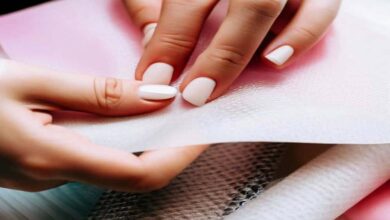Can You Spray Lysol on Fabric? The Ultimate Guide

Yes, you can safely spray lysol on fabric to eliminate germs and odours. When used correctly, Lysol can effectively disinfect fabric surfaces without causing damage.
Following the instructions on the product label and allowing the fabric to dry before using or wearing it fully is essential. Additionally, avoid spraying lysol directly on sensitive or delicate fabrics, and test in an inconspicuous area before applying it to the entire fabric surface.
Taking these precautions will help ensure effective disinfection while maintaining the integrity of the fabric. Regularly disinfecting fabric surfaces can help reduce the spread of germs and keep fabrics clean and fresh.
Can You Spray Lysol On Fabric?

Yes, you can spray Lysol on fabric. Lysol is a disinfectant spray that is commonly used to kill germs on hard surfaces. While it can effectively disinfect some fabrics, it’s essential to use it properly to avoid damaging the fabric or causing any adverse effects.
Factors To Consider Before Spraying Lysol On Fabric
Here are some guidelines to consider:
Fabric Care Labels And Instructions
- Check the fabric care labels and instructions: Before spraying Lysol on any fabric, reviewing the fabric care labels and instructions is essential. These labels guide how to clean and care for the fabric safely. Look for any specific instructions regarding disinfectants or chemicals on the fabric.
- Follow the recommended cleaning methods: Fabric care labels often indicate the recommended cleaning methods, such as handwashing, machine washing, or dry cleaning. Ensure that using Lysol spray aligns with the recommended cleaning method for the fabric. If in doubt, contact the manufacturer or consult with a professional cleaner.
- Consider the fabric type: Different fabrics may react differently to lysol spray. Delicate fabrics or those with sensitive dyes may be more prone to damage or discolouration. Take into account the fabric type before deciding to spray Lysol on it.
Testing Lysol Spray On A Small, Inconspicuous Area
- Identify a hidden or inconspicuous area: Before applying Lysol spray on a fabric item, selecting a small, hidden spot to test the product is crucial. Look for an area that won’t be easily noticeable, such as the inside seam or an inconspicuous corner.
- Spray a small amount of Lysol: Apply a small amount of Lysol spray to the chosen area. Ensure it is minimal to minimize the potential for damage or discolouration.
- Wait and observe: Allow the sprayed area to dry completely. Observe any changes in the fabric’s colour, texture, or overall appearance. If there is no noticeable damage or discolouration after 24 hours, using Lysol spray on the fabric may be safe.
Potential Damage And Discoloration Risks
- Risk of damage and discolouration: Spraying Lysol on fabric carries the potential risk of causing damage or discolouration. Certain fabrics, such as silk or satin, are more delicate and susceptible to adverse reactions. Additionally, fabrics with specific dyes or finishes may also be more prone to damage.
- Bleaching effect: Lysol spray contains chemicals that may have a bleaching effect on fabrics. This can result in colour fading or lightening of the treated area. Use caution when spraying lysol on coloured or vibrant fabrics.
- Stain or residue: Sometimes, Lysol spray might leave a stain or residue on the fabric. This can be more noticeable on lighter-coloured fabrics. It’s advisable to test a small area first and inspect for any staining or residue before spraying the entire fabric item.
Remember, when considering spraying lysol on fabric, it’s important to review fabric care labels, perform a spot test, and be mindful of potential damage and discolouration risks.
By following these factors, you can make informed decisions and protect your fabrics while effectively disinfecting them.
How Do You Use Lysol On Fabric?

Lysol is a popular disinfectant that is commonly used to kill germs and bacteria on surfaces. However, when it comes to using Lysol on fabric, there are some guidelines to ensure effectiveness without causing damage.
Here’s how you can use Lysol on fabric:
- Check the fabric label: Before using Lysol on any fabric, it’s essential to check the care label for any specific cleaning instructions. Some fabrics may require special care or may not be compatible with Lysol.
- Spot test: To ensure that lysol doesn’t damage or discolour the fabric, it’s always a good idea to spot-test an inconspicuous area first. Apply a small amount of Lysol to the fabric and wait a few minutes to see if any adverse reaction occurs.
- Proper dilution: Lysol should be diluted according to the manufacturer’s instructions. Mixing one part Lysol with five parts water for fabric disinfection is recommended.
- Spray from a distance: When applying Lysol to fabric, it’s essential to spray from a distance to coat the surface evenly. Avoid saturating the fabric to prevent excessive moisture buildup.
- Allow to dry: After spraying Lysol on the fabric, let it air dry completely before using or folding the fabric. This ensures the disinfectant has sufficient time to kill any bacteria or germs on the fabric.
- Washing instructions: In most cases, washing the fabric after applying Lysol is recommended. Follow the fabric’s washing instructions to remove any residue and ensure cleanliness.
Always use Lysol in a well-ventilated area and follow any additional precautions mentioned on the product label. Following these guidelines, you can effectively use Lysol on fabric to keep it clean and germ-free.
For visual understanding, watch the video.
Will Lysol Stain Fabric?
Lysol, a typical disinfectant spray, can risk staining fabrics if not used carefully. The potential for staining depends on factors such as fabric type, colour, Lysol concentration, and exposure duration.
Chemical reactions between Lysol’s active ingredients and fabric dyes can cause discolouration or staining, especially in fabrics that are not colourfast or sensitive to chemicals.
Over-saturation of fabric is another concern. Excessive Lysol application or direct spraying onto fabric can lead to saturation, potentially resulting in stains.
The proper application involves misting the fabric lightly from a reasonable distance, allowing for even distribution and avoiding soaking.
Certain fabrics, like silk, wool, and delicate synthetics, are more prone to damage or staining when exposed to disinfectants. Conducting a spot test on an inconspicuous area is crucial to gauge any adverse reactions beforehand.
Additionally, thorough air drying post-application is essential to prevent lingering Lysol from causing staining or other issues.
Alternative options, such as fabric-safe disinfectant sprays, may be considered for those worried about staining. These are formulated to minimize the risk of spoiling while effectively disinfecting fabrics.
In summary, employing Lysol on fabric necessitates caution. Adhering to guidelines, like conducting spot tests, maintaining proper application distances, and using fabric-safe disinfectants, can help mitigate staining risks.
Following care instructions for both the disinfectant and the fabric itself is pivotal to safeguarding textiles from potential harm or discolouration.
Frequently Asked Questions Of Can You Spray Lysol On Fabric?
Is Lysol Safe For All Types Of Fabric?
Lysol is generally safe for most fabric types, including cotton, polyester, and nylon. However, it’s always a good idea to first test it on a small area to ensure compatibility. Avoid using Lysol on delicate fabrics or those labelled as “dry clean only.
Does Lysol Kill Germs On Fabric?
Yes, Lysol kills germs on fabric. When sprayed onto fabric, Lysol disinfects the surface, killing bacteria and viruses. It’s an effective way to sanitize items that are difficult to wash, such as upholstery, curtains, and bedding. Remember to follow the instructions and allow sufficient drying time.
Conclusion
Spraying Lysol on fabric can quickly and effectively freshen up textiles and eliminate unpleasant odours. However, it is essential to approach this method with caution to avoid any potential damage.
Lysol contains chemicals that can harm certain fabrics, so it is crucial to test a small, inconspicuous area before treating the entire fabric.
If the fabric does not show any adverse reactions, proceed with spraying lysol lightly and evenly, ensuring that the fabric is not soaked. Allow the fabric to dry thoroughly before using or wearing it.
Always follow the instructions on the Lysol packaging and exercise proper ventilation when using the product.
With the right precautions, spraying Lysol on fabric can be a helpful and convenient way to maintain cleanliness and freshness in your home.



